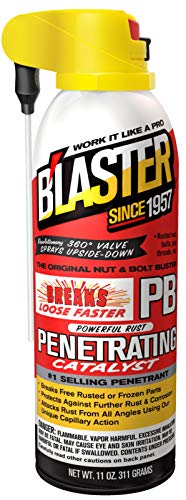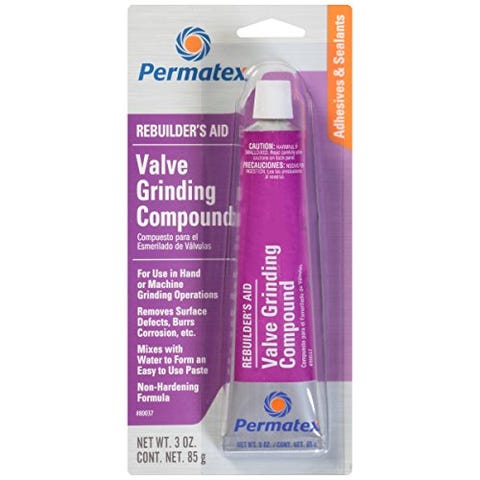How to Remove a Rusted Screw From Metal
How To Remove Rusted Screws and the Products To Use
Removing rusted screws from a fixer-upper car can be a frustrating process. But if you know a few tips and tricks, you can make small(er) work of removing rusted screws from your vehicle, or most anything else.
Below, you'll find a guide to removing those stubborn screws, as well as some of the highest-rated products on Amazon that might come in handy.
Types of Products for Removing Rusted Screws
Basically, your products for removing rusted screws are going to fall into two categories: chemicals and tools. You might need to alternate between the two to remove screws that have been left to rust a long time.
Your chemical products, such as WD-40 Specialist Rust Release or PB Blaster, are designed to get into the cracks in rust and give you more of a chance to remove it. Hopefully, you can get the job done with a socket wrench or screwdriver, but you may have to resort to brute force tools if the rusted screw puts up too much of a fight.

WD-40 Specialist Rust Release Penetrant Spray with Blu Torch and SMART STRAW SPRAYS 2 WAYS, 11 OZ

B'laster 16-PB Penetrating Catalyst - 11-Ounces
How To Remove Rusted Screws
Disclaimer: The guidelines in this story are general and not meant to replace instructions for your specific vehicle. Please consult your owner's manual or repair guide before attempting repairs.
Break It Up
The first step in removing a rusted screw is to give it a couple of taps with a hammer. The idea here is that you need to break up the rust seal that's holding the screw in place. You don't need to hit the screw as hard as you can — just give the head a few sturdy whacks. Try to hit the screw all around the side of the head if it's an option. Hit any reachable part of the screw to loosen it up as much as you can.
Try removing the screw normally after you do this. Sometimes, this step is all it takes to loosen up a rusted screw. If this doesn't work, move on to the next step.
Use Rust Penetrant
Hopefully, your hammering on the screw has created some fractures in the rust that's bonding your screw to the area around it. The next step in the process of removing rusted screws should be to spray a rust penetrant on and around the screw head and any other visible part of the screw. You can use WD-40 Specialist Rust Release, PB Blaster, Liquid Wrench, or a similar product of your choice for this step.
If you don't want to or can't use these products, you can use more common household items as substitutes. Try cola, lemon juice, or hydrogen peroxide.
Be sure to let the rust penetrant sit on the screw for at least 15 minutes or follow the specific instructions your chosen product gives you. After that time passes, try to remove the screw as you normally would. If your screwdriver keeps popping out of the groove in the screw head, be careful you're not stripping the groove.
If the screw still won't budge, hit it a few more times with a hammer to help push the rust penetrant deeper into the screw's threads. The vibrations may shake some of the chemicals around the screw. Wait a couple of minutes and try to remove the screw again.

Liquid Wrench Gunk L112/6 Super Penetrant Spray - 11 oz, Gray
Liquid Wrench amazon.com
$14.99
The Heating Method
If the above method doesn't work, try heating the screw. Be certain that any chemical you have used on the screw or in the immediate area is not flammable before you try this.
To do this, simply take a lighter or small torch on low to moderate heat and hold it up to the screw for 5-15 seconds. Be careful — it's hot. The heat from the flame can cause the metal of the screw to expand, which might break up some of the rust sealing it to the material in which it's screwed. Try to remove the screw normally after it has cooled down a bit.
This method is best suited for screws lodged in metal, as the area around the stuck screw can expand too. Avoid using the heating method on materials that are more likely to melt.
Get a Grip
As we mentioned above, you should stop trying to remove the screw with a screwdriver if it starts slipping out of the groove. If you need to get a better grip on the screw, apply an automotive valve grinding compound such as Permatex to the screw's head to boost your grip on it. You can substitute this with powder kitchen cleaner and a few drops of water.
Once you apply the paste, push your screwdriver into it and try to remove the screw normally. Apply downward pressure to maintain your grip as you try to twist the screw out.

Permatex 80037 Valve Grinding Compound, 3 oz. , White
Permatex amazon.com
$8.02
When All Else Fails, Cut It Out
Sometimes screws get so rusted over that it's nearly impossible to remove them, even with lubrication. If no other method will work, it might be time to try to cut it out. If the screw has a head that you can adhere a clamp to, do so and use great force to snap it off. It's possible you may finally get the screw loose this way.
You might also choose this method if the screw's head is so damaged or corroded that you can't use a screwdriver or a pair of pliers. Use a screw extractor set to remove the stuck screw. Slowly drive a cobalt drill bit into the screw head. Replace the bit with a screw extractor bit, switch your drill to its reverse setting, and begin drilling into the small hole you created with the cobalt bit.
Your screw extractor may be double-ended to serve both as the pilot hole creator and the screw extractor. If this is the case, you may be able to use just the screw extractor bit. But if you're removing heavier, tougher bolts, you may need a more heavy-duty drill bit to make your hole. Be sure to take it slow when you're removing a screw with a screw extractor, as you'll need to give the bit a chance to grab onto the sides of the hole you created.
This content is created and maintained by a third party, and imported onto this page to help users provide their email addresses. You may be able to find more information about this and similar content at piano.io
How to Remove a Rusted Screw From Metal
Source: https://www.caranddriver.com/car-accessories/a38162650/how-to-remove-rusted-screws/